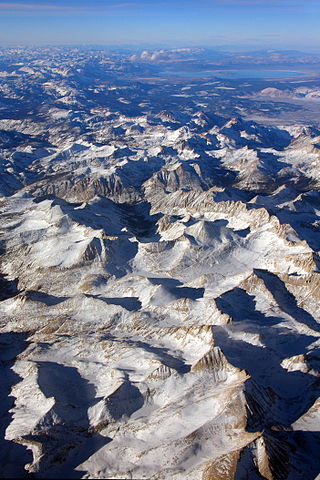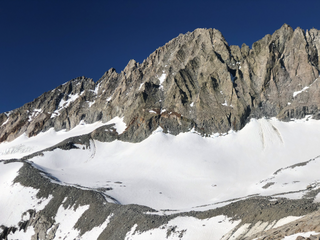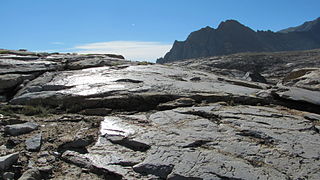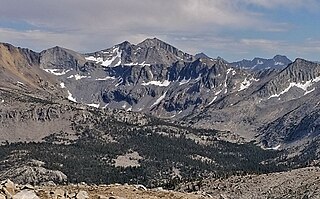
The Sierra Nevada is a mountain range in the Western United States, between the Central Valley of California and the Great Basin. The vast majority of the range lies in the state of California, although the Carson Range spur lies primarily in Nevada. The Sierra Nevada is part of the American Cordillera, an almost continuous chain of mountain ranges that forms the western "backbone" of the Americas.

The John Muir Trail (JMT) is a long-distance trail in the Sierra Nevada mountain range of California, passing through Yosemite, Kings Canyon and Sequoia National Parks. It is named after John Muir, a naturalist.

The Ansel Adams Wilderness is a wilderness area in the Sierra Nevada of California, United States. The wilderness spans 231,533 acres (93,698 ha); 33.9% of the territory lies in the Inyo National Forest, 65.8% is in the Sierra National Forest, and the remaining 0.3% covers nearly all of Devils Postpile National Monument. Yosemite National Park lies to the north and northwest, while the John Muir Wilderness lies to the south.

Kings Canyon National Park is an American national park in the southern Sierra Nevada, in Fresno and Tulare Counties, California. Originally established in 1890 as General Grant National Park, the park was greatly expanded and renamed on March 4, 1940. The park's namesake, Kings Canyon, is a rugged glacier-carved valley more than a mile (1,600 m) deep. Other natural features include multiple 14,000-foot (4,300 m) peaks, high mountain meadows, swift-flowing rivers, and some of the world's largest stands of giant sequoia trees. Kings Canyon is north of and contiguous with Sequoia National Park, and both parks are jointly administered by the National Park Service as the Sequoia and Kings Canyon National Parks.

The John Muir Wilderness is a wilderness area that extends along the crest of the Sierra Nevada of California for 90 miles (140 km), in the Inyo and Sierra National Forests. Established in 1964 by the Wilderness Act and named for naturalist John Muir, it encompasses 652,793 acres (2,641.76 km2). The wilderness lies along the eastern escarpment of the Sierra from near Mammoth Lakes and Devils Postpile National Monument in the north, to Cottonwood Pass near Mount Whitney in the south. The wilderness area also spans the Sierra crest north of Kings Canyon National Park, and extends on the west side of the park down to the Monarch Wilderness.

Split Mountain is a fourteener in the Sierra Nevada of the U.S. state of California, near the southeast end of the Palisades group of peaks. It is the only fourteener in the watershed of the South Fork Kings River, and it rises to 14,064 feet (4,287 m), making it the eighth-highest peak in the state.

Middle Palisade is a 14,018-foot (4,273-meter) peak in the central Sierra Nevada mountain range in the U.S. state of California. It is a fourteener, and lies on the Sierra Crest as part of the Palisades group, a group of prominent Sierra Nevada mountain summits that includes multiple other fourteeners, approximately 12 miles (19 km) southwest of the town of Big Pine. Middle Palisade is the twelfth highest peak in California.

The Sierra High Route is a cross-country hiking route, 195 miles (314 km) long, through the Sierra Nevada. It was scouted by Steve Roper and described by him in his book Sierra High Route: Traversing Timberline Country.

Forester Pass is a mountain pass in the Sierra Nevada. Located on the Kings-Kern Divide and on the boundary between Sequoia National Park and Kings Canyon National Park, Forester Pass connects the drainages of Bubbs Creek and the Kern River. The pass is traversed by the John Muir Trail and the Pacific Crest Trail, which are coincident between Crabtree Meadows and Tuolumne Meadows. At 13,153 feet (4,009 m), Forester Pass is the highest point along the Pacific Crest Trail. It is also the southernmost of the six high mountain passes above 11,000 feet along the John Muir Trail, with Donohue Pass, Muir Pass, Mather Pass, Pinchot Pass, and Glen Pass.

The South Fork Kings River is a 44.1-mile (71.0 km) tributary of the Kings River in the Sierra Nevada of Fresno County, California. The river forms part of Kings Canyon, the namesake of Kings Canyon National Park and one of the deepest canyons in North America with a maximum relief of 8,200 feet (2,500 m) from rim to river.

Taboose Pass, 11,417 ft (3,480 m), also known as Wide Gap, is a mountain pass in the southern Sierra Nevada, California on the border of the Inyo National Forest to the east and Kings Canyon National Park to the west. The pass is reachable from the east via a long, strenuous hike from the desert floor of the Owens Valley. On the west, it connects to the Pacific Crest Trail/John Muir Trail in the National Park.

Mount Perkins is a 12,566-foot-elevation mountain summit located on the crest of the Sierra Nevada mountain range in northern California. It is situated on the common border of Fresno County with Inyo County, as well as the boundary between John Muir Wilderness and Kings Canyon National Park. It is 13.5 miles (21.7 km) northwest of the community of Independence, 1.65 miles (2.66 km) north of Mount Cedric Wright, 2.2 miles (3.5 km) east of Crater Mountain, and 1.4 miles (2.3 km) southeast of Mount Wynne. Climbing routes to the summit include the west slope, and the north and south ridges. The John Muir Trail traverses below the west base of the peak on its descent south from Pinchot Pass, providing an approach to the mountain.

Disappointment Peak is a 13,917-foot-elevation summit located on the shared boundary of Fresno County and Inyo County in California, United States.

Pyramid Peak is a 12,779-foot-elevation (3,895 meter) mountain summit located west of the crest of the Sierra Nevada mountain range, in Fresno County, California, United States. It is situated in Kings Canyon National Park, 2.2 miles (3.5 km) southwest of line parent Mount Ickes and 2.2 miles (3.5 km) southeast of Arrow Peak, which is the nearest higher neighbor. Other nearby peaks include Crater Mountain 2.5 miles (4.0 km) to the northeast, and Window Peak one mile to the south. Pyramid Peak ranks as the 214th-highest summit in California, and topographic relief is significant as the southwest aspect rises over 2,300 feet in approximately one mile.

Mount Bolton Brown is a 13,491-foot-elevation (4,112 meter) mountain summit located on the shared border of Fresno County and Inyo County in California, United States.

Mount Prater is a 13,471-foot-elevation (4,106 meter) mountain summit located on the shared border of Fresno County and Inyo County in California, United States.

Mount Jepson is a 13,390-foot-elevation (4,081 meter) summit located on the shared boundary of Fresno County and Inyo County in California, United States.

Aperture Peak is a 13,265-foot-elevation mountain summit located in Inyo County, California, United States.

Pinchot Pass is a high mountain pass in the Sierra Nevada mountain range of California, in the United States. It lies within far eastern Fresno County, inside Kings Canyon National Park and the Sequoia-Kings Canyon Wilderness.




















